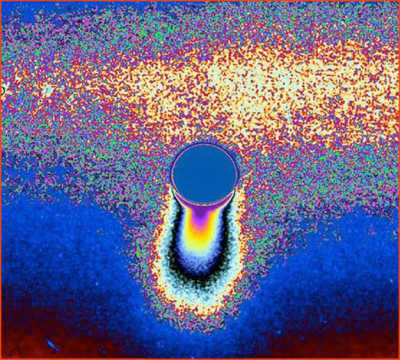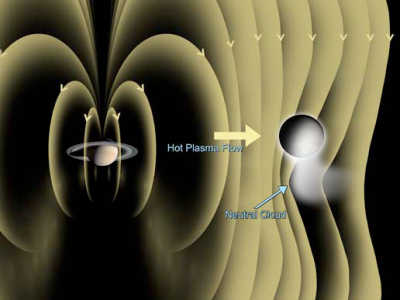|
|
Space - The Latest, Greatest Surprises (Part 1)
by David Talbott
|
|
December 30, 2008
|
|
|
In the history of scientific discovery nothing has been more central to progress than the
value of successful predictions. Predictive success in the sciences does not just mean
the ability to anticipate a future discovery. It really signifies the degree to which all
relevant observations and quantified behavior become predictable when viewed in the
light of a defined theory.
But when it comes to the forces that shape new directions in the sciences, nothing is
more powerful than the successful prediction of new findings that were not expected, or
were considered implausible, or even thought impossible under prior theory.
This is why advanced predictions registered by Wallace Thornhill and his colleagues are
having such an impact today. Thornhill has consistently anticipated space age findings
that were the farthest thing from the minds of NASA scientists. To get a first impression
of what this might mean, go to the
"Predictions"
page at Thunderbolts.info.
Thornhill and others associated with the Thunderbolts Project believe that something is
fundamentally wrong in the space sciences today. A single assumption, gathering
momentum through most of the twentieth century, confined theoretical imagination to a
narrow field of view. The majority of astronomers, astrophysicists, cosmologists, solar
physicists, and planetary scientists have assumed that interplanetary, interstellar, and
intergalactic space are electrically inactive. Perhaps this assumption was
understandable before the space age, even if numerous pioneers of todayís electrical
knowledge suggested otherwise. But decades of direct exploration, including long
distance probes and new telescopes reading the full electromagnetic spectrum, have
changed the earlier picture completely. Electric currents and the resulting magnetic
fields - at all scales of observation - can no longer be rationally denied.
An extraordinary fact has emerged from recent investigation. Almost all of the major
discoveries are coming as great surprises to scientists conditioned by the twentieth
century dogma of electrical inactivity in space. And these surprises have consistently
revealed electrical events where nothing electrical was expected.
So what does it mean when a steady stream of "surprises," all leaving astronomers
grasping for explanations, are not surprises from an electrical perspective? Perhaps we can
draw closer to the needed shift in perception by simply listing "The Latest Greatest
Surprises" that have greeted astronomers and planetary scientists.
No. 1óThe Comet-Like Moon Enceladus
|
|
|

Ice jets from Saturnís small moon Enceladus explode from the surface in cometlike
fashion,
to feed material into Saturnís E ring.
Credit: NASA/JPL/Space Science
Institute
[Click on image to enlarge]
|
|
|
It seems that Saturnís little moon Enceladus continues to astonish NASA investigators.
No one had expected anything like the active "geysers" discovered on the small moon,
about the size of Iowa, in 2005. “We're amazed to see ice
geysers on this little world
that was thought to be cold and dead long ago,” said one NASA investigator. In
mechanical terms, no such activity is really plausible on a frozen rock. And certainly tidal
flexing from gravitational interactions with Saturn - even if that were sufficient to warm
ice beneath the surface - would not concentrate the energy in the south polar region,
from which the plumes arise.
For Wal Thornhill and proponents of the Electric Universe, all of the evidence suggests
that the plumes are electric discharge jets, created as the moon moves through Saturnís
electrified domain. These theorists compare the plumes of Enceladus to similar
collimated (narrowly confined) jets of comets as they move through the radial electric
field of the Sun.
In March, 2008, the Cassini probe plunged into the Enceladus plume, and its Neutral
Mass Spectrometer (INMS) measured the ion, or positively charged particle,
composition for the first time. Surprisingly, the measurements indicated a considerable
abundance of organics -
“beyond what we expected,” according
to INMS lead scientist
Hunter Waite of the Southwest Research Institute in San Antonio, Texas, US.
“And the
composition is very like the composition of a comet.” [emphasis added]
The New Scientist website
reported
on the surprise:
“This is very exciting,” says Cassini
scientist Julie Castillo of NASA's Jet Propulsion Laboratory in Pasadena, California, US.
“It indicates that Enceladus and comets were made of the same initial materials, and/or
affected by similar internal processes.” she told New Scientist.
That is rather puzzling because comets are thought to have formed far from the Sun,
out in the region of Uranus and Neptune, says INMS co-investigator Roger Yelle of the
University of Arizona in Tucson, US. Enceladus, on the other hand, is thought to have
grown within the "Saturnian subnebula" - the cloud of gas that coalesced into Saturn
and its major moons.
“The temperature and pressure should have been very different, so you should get
different gases,” Yelle told New Scientist.
But readers familiar with the Electric Universe hypothesis know that there is no surprise
here. In this interdisciplinary and radical re-envisioning of solar system history, comets
are not formed independently from planets. Rather, they are fragments of planets and
moons produced in episodes of intense solar system catastrophe in the past.
Thus, the prediction inherent in the Electric Universe hypothesis: the more
thoroughly the plume of Enceladus is investigated, the more clearly its
electrochemistry will reveal a signature of electric discharge and surface sputtering by proton beams. Indeed,
investigators now report an apparent dominating presence of the ion H3O+, at least
eight times the abundance of other ion species (including H2O+, OH+, O+). The
instruments did not observe appreciable ion abundances just outside the plume, so
the electro-chemistry of the plume itself is clearly distinguished from its
surroundings, as the electric model would predict. And the question posed by the
investigators themselves could well settle the matter once and for all: What
dynamic process will explain a
“plume ionosphere in which ion-neutral chemistry
rapidly converts virtually all ions species into H3O+ ions”?
It should go without saying that this baffling chemistry is never going to be
explained in the absence of electric discharge events.
But will the specialists seeking to answer this question explore the chemistry of electric
discharge acting on an icy surface? Or will they simply
strain more mightily to find new ways to hold on to a theory that is not working? Surely,
if NASA investigators will allow into their lexicon the word "electricity," a new pathway of
discovery will open in planetary science. But to put this possibility into perspective, try a
web search for "Enceladus" and "electric." Almost all of the returns you will get point to
articles and observations on websites devoted to explorations of the Electric Universe -
sites entirely ignored by NASA officials.
|
|
|

The graphic above illustrates the magnetic field observed by Cassini,
as well as the "deflection" of the cloud being vented from the south pole of Enceladus.
Credit: NASA/JPL
[Click on image to enlarge]
|
|
|
In this web search you will find almost nothing from NASA--but with
one exception. It seems that on three flybys of Enceladus in 2005 -
Feb. 17, March 9 and July 14 - the magnetometer on Cassini detected
something unusual. The instrument was designed to measure the magnitude
and direction of the magnetic fields of Saturn and its moons. According
to a Cassini
team report, the instrument “detected
a bending of the magnetic
field around Enceladus due to electric currents generated by the
interaction of atmospheric particles and the magnetosphere of
Saturn.”
That sounds like the discovery of electric currents and the solution
are all wrapped up, doesn't it? Of course, the interpretation is based
entirely on a theoretical assumption - that the dynamo action of Saturn's
rotating magnetosphere can "explain" the electric currents above
Enceladus. But is that sufficient? The outbursts from Enceladus are like
those of comets, which are not subject to Saturn's magnetic field. The
Electric Universe provides the unifying concept of surface electric
discharge to explain the jets on comets, the hot 'geysers' on Enceladus
and far-flung Neptune's moon, Triton, and the much hotter 'volcanoes' on
Io. Thus, the Electric Universe requires a fundamental readjustment in
viewpoint such that electric currents and circuits in space are seen as
the cause, rather than the effect of magnetic fields.
In the absence of this larger field of view, NASA scientists will continue
to ignore electric currents, even when their presence is undeniable. Thus,
it is not surprising that neither NASA investigators nor scientific media
saw a story in the recent discovery, and the findings simply disappeared
from discussion. And it seems that no one has yet wondered if electric
currents could have anything to do with the dramatic conversion of
Enceladus' plume ions into H3O ions.
References:
Enceladus
Cracks and Creaks (tpod)
Enceladus
Plumes Explained? (tpod)
The
Moving "Geysers" of Enceladus (tpod)
http://www.agu.org/[a]
http://www.agu.org/[b]
NEXT: "The Earth-Sun Connection"
|
|
|
Permalink to this article.
Public comment may be made on this article on the
Thunderbolts Forum/Thunderblogs (free membership required).
|
|
|
|
|
|
|






